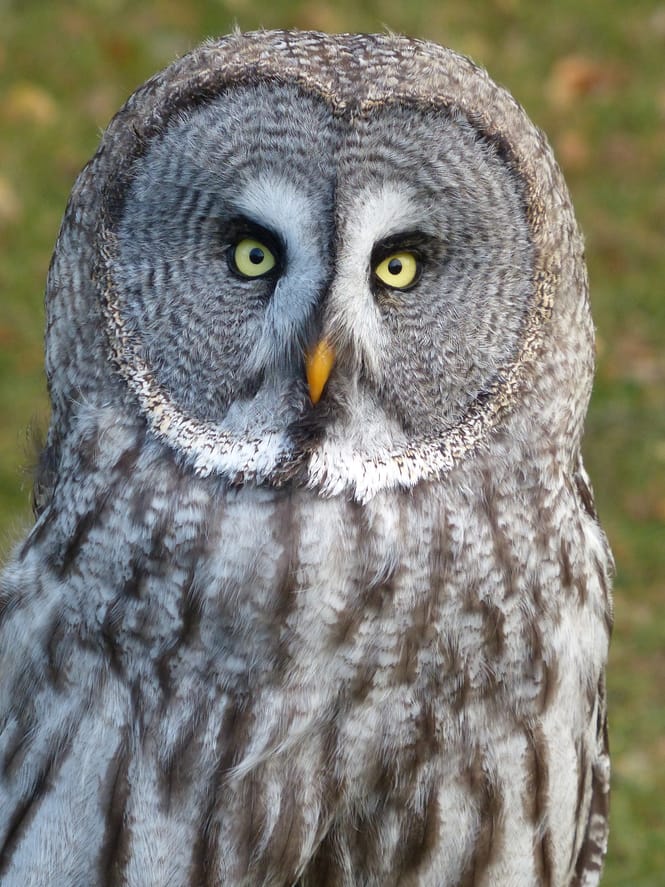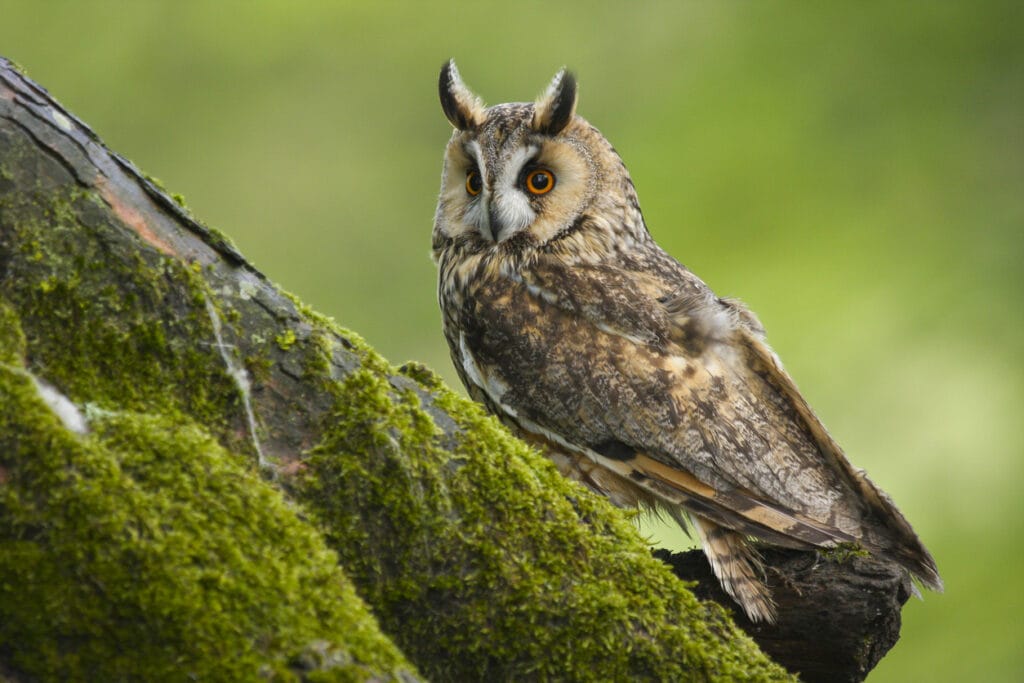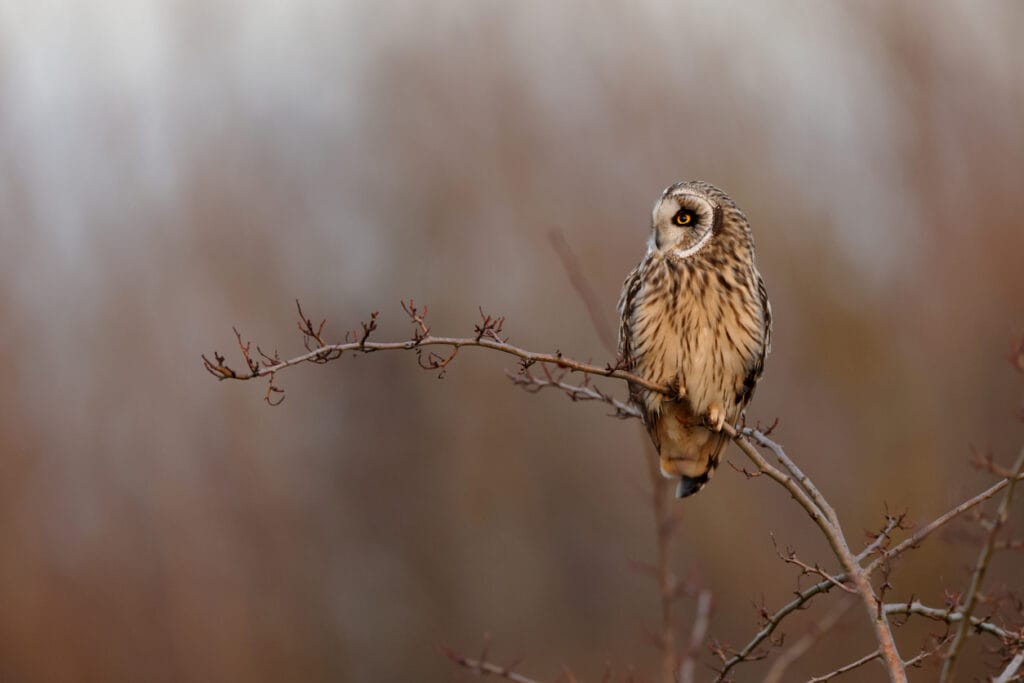Everything about Wisconsin makes it the perfect habitat for owls and similar predatory birds. Between its reasonable weather and vast woodlands, it’s no wonder the state hosts more than 400 bird species.
Along Lake Michigan’s coastline and Lake Superior’s shores, many animals and birds live, breed, and feed on the state’s greens. The humid weather helps them adapt, and the wildlife encourages them to stay.
There are 23 forest areas in Wisconsin. Paired with the water streams and swamps, they make the perfect home for 11 species of owls. Out of these 11 species, only five live permanently in the state.
If you want to find more about owls in Wisconsin, go on with this article.
1. Barn Owl

- Scientific Name: Tyto furcata
- Length: 12.6–15.7 inches
- Weight: 15–22 ounces
- Wingspan: 42.1– 43.5 inches
Barn Owls are among the most widespread owl species in the world, and they’re the most common species in North America. Granted, their numbers aren’t abundant in Wisconsin, especially during the winter.
In fact, until recently, no Barn Owl nest was spotted in the state for more than 20 years. So it’s needless to say, barn owls aren’t fans of the weather in Wisconsin.
These owls mostly live in abandoned caves and barns, and they nest inside dead tree cavities. When they hunt in the night, they look like ghosts because of their entirely white faces. That’s why some people call them Ghost Owls.
Author Note: Barn Owls are nocturnal, so your chances of seeing them during the day are slim. You may see them inside their nests, but other than that, the nighttime is better for bird watching.
These owls are known for their impressive hearing sense. They use it at night to hunt for mice and rodents.
The way they hunt, they glide slowly over the woodlands, beating their wings slowly as not to produce a sound. Their preferred hunting time is at dusk.
2. Barred Owl

- Scientific Name: Strix varia
- Length: 16–25 inches
- Weight: 1–2.75 pounds
- Wingspan: 38–49 inches
Barred Owls stay in Wisconsin for the whole year, and they’re spotted in various locations across the state. You can see them in the Pheasant Branch Conservancy or in the Yellowstone and Pine Island State Wildlife Areas.
They become more apparent in February and Match, so you may have a better chance at seeing them around that time.
These owls are highly territorial. When they see intruders near their nests, they keep hooting loudly to deter them. The females are known to get exceptionally aggressive during their nesting season. They won’t hesitate to strike their enemies with their talons if they sense a threat.
Barred Owls are dangerous, even to humans. When they see a human messing with their nests or getting too close, they start flapping their wings vigorously, and they may attack if the human doesn’t get the hint.
These owls feed on small rodents, snakes, and smaller birds. The biggest threat to their existence is the Great Horned Owl, which feeds on their populations regularly.
3. Burrowing Owl

- Scientific name: Athene cunicularia
- Length: 7.5–9.8 inches
- Weight: 5.3 ounces
- Wingspan: 21.6 inches
The population of Burrowing Owls has been steadily declining for some years now in Wisconsin. The owls prefer living in the desert or in open, dry areas, so they’ve been migrating from the state in pursuit of a more suitable habitat. That’s especially since their habitats have been lost.
Still, you may be lucky enough to see a couple of Burrowing Owls in Wisconsin. They’re endangered, but not completely non-existent
Burrowing Owls live in underground burrows that they make themselves, hence their name. When they can’t find a suitable place for a burrow, they’ll steal one from a ground squirrel.
Author Note: Because these owls mainly live in dry areas, their diet consists of amphibians, mammals, and reptiles. They also roost during the day to look for insects to feed on.
4. Great Horned Owl

- Scientific Name: Bubo virginianus
- Length: 18–25 inches
- Weight: 49–55 ounces
- Wingspan: Approximately 55 inches
Great Horned Owls are often regarded as the deadliest owls on earth, and that’s not far from the truth. They’re opportunistic eaters. In other words, they eat whatever animal they find in their way, whether it’s a cat, rabbit, rodent, or even a fellow owl.
Great Horned Owls live close to cliffs and on the edge of forests. In Wisconsin, you can see them in state parts, including Big Foot Beach and Big Hill parks. They like hiding in thick bushes and tree cavities. It’s also not uncommon to find them roosting in human-made structures.
These owls are at their most active at dusk. Their activity also increases before dawn because they hunt for food.
If you see a Great Horned Owl hunting in the early morning, know that the food is likely scarce.
When these owls feel a threat close to home, they start hissing and calling out loudly, sometimes screaming. They’ll also not hesitate to strike their prey with their talons.
5. Great Gray Owl

- Scientific Name: Strix nebulosa
- Length: 24.0–33.1 inches
- Weight: 24.7–60.0 ounces
- Wingspan: 53.9–60.2 inches
Great Gray Owls are among the largest on earth, and they’re the largest species on this list. They’re close to snowy owls and great horned ones, but they’re often bigger. Their wingspan is also impressive, spreading to reach as far as five feet.
These owls mostly live in areas with dense vegetation and coniferous forests. They build their nests on pine trees, and they prefer to stay away from human-made structures.
Granted, I wouldn’t want to see a great grey owl on my doorstep. The feeling is mutual, fellow!
Like Great Horned Owls, Great Gray ones will eat anything they come across. They mainly feed on rodents, but they wouldn’t mind eating rabbits, ducks, or cats when they feel like it.
These owls aren’t very common in Wisconsin, so it may be a bit challenging to spot them. The chances of seeing them are higher in the winter, though. They’re also more likely to appear at Willow Flowage, where a lot of birds stay during their migration season.
6. Eastern Screech-Owl

- Scientific Name: Megascops asio
- Length: 6–10 inches
- Weight: 4.2–8.6 ounces
- Wingspan: 18–24 inches
Eastern Screech-Owls are one of five species that live permanently in Wisconsin. You can spot them in various locations across the state, especially near the Rockies Mountain Range or in the Cave of the Mounds landmark.
These owls prefer to live in deciduous forests, wetlands, suburban woodlands, and meadows. They also tend to hide in mature orchards when they find them. You’ll likely only spot them at night because that’s when they’re hunting, particularly at dusk or dawn.
Top Tip: Some of them occasionally hunt in the daylight, but it’s not common.
The way Eastern Screech-Owls hunt, they stay on high perches silently, waiting for an animal to appear that they can feed on. When they see it, they pounce down in an instant, grabbing the animals and flying away. Sometimes, they drop their talons in shallow water to catch fish, but that’s not a common sight to see in Wisconsin.
Eastern Screech-Owls have a bit of an odd flight pattern. Instead of gliding as most owls do, they fly in upwards and downwards motions, creating a U shape with their bodies.
7. Northern Saw-Whet Owl

- Scientific Name: Aegolius acadicus
- Length: 7–9 inches
- Weight: 4 ounces
- Wingspan: 16–24 inches
Northern Saw-whet Owls are incredibly small compared to other owl species. Put a saw-whet next to a snowy owl, for example, and you’ll see a funny difference. Unfortunately, the small size puts saw-whets at the risk of being eaten by larger owls.
They’re commonly preyed on by Great Horned Owls and other large species.
Northern Saw-whets prefer to build their nests in dense vegetation and deciduous forests. During the day, they roost, and they come out to hunt during the nighttime. Like all owls, they eat rodents and small animals.
Saw whets aren’t very common in Wisconsin, so there’s a chance you’ll only see them in the northern counties. You may see more of them in the state during their migration season.
8. Long-eared Owl

- Scientific Name: Asio otus
- Length: 14–16 inches
- Weight: 9 ounces
- Wingspan: 35.5–39 inches
Long-eared Owls are best known for roosting in colonies. They don’t live alone; instead, they form large colonies and live inside. That’s why they need open habitats to accommodate their numbers.
Long-eared owls are masterful camouflagers, and their color helps them further hide against trees and similar nature objects. You may identify them instantly thanks to the long tufts on top of their heads. They’re sometimes mistaken for ears, but they’re not.
Author Note: Generally, Long-eared Owls are easy to spot among their groups. They tend to live in mixed woodlands, so you may find them in the Brooklyn State Wildlife Area in Wisconsin. They live in the state for the whole year.
9. Short-eared Owl

- Scientific Name: Asio flammeus
- Length: 13–17 inches
- Weight: 7.3–17 ounces
- Wingspan: 33– 43.5 inches
Contrary to Long-eared Owls, Short-eared ones don’t live in Wisconsin. You may see them in the state occasionally, but they’re not permanent residents.
These owls prefer to live in tundras and prairies, where they nest on the ground. They usually create their nest and cover it with vegetation. Of course, the nests are easy to find; if you’re lucky, you may slip your feet through one of them while you’re bird watching.
Short-eared Owls feed on all kinds of small animals, including moles, squirrels, shrews, and even bats. Like all owls, their primary food is rodents. They’re also known for having a couple of tricks up their sleeves for hunting.
For example, they sometimes jump on one leg to act as if they’re disabled. That way, the prey doesn’t see them as a threat.
These owls have short tufts on their heads that are barely visible. You’ll only see them if you’re close enough to the owl.
10. Boreal Owl

- Scientific name: Aegolius funereus
- Length: 8.3–11.0 inches
- Weight: 3.3–7.6 ounces
- Wingspan: 21.6–24.4 inches
Boreal Owls are native to the boreal forests, hence their name. These forests range from Alaska to the northern US. There are also boreal forests in Finland, Sweden, and other Eastern European countries.
So what brings these owls to Wisconsin? The truth is, they don’t come by a lot. You’d be lucky to see them once in a cold winter, where they come to the state looking for food. Other than that, the chances are pretty slim.
Boreal Owls eat voles, mice, and similar rodents. They also regularly feed on insects, ridding the forests of them. You won’t see Boreal Owls during the day because, aside from the fact that they’re strictly nocturnal, they’re also quite shy. They don’t like to make their presence known.
These owls are best known for their dish-shaped, large faces and wide yellow eyes. They’re on the smaller side of the scale, being only a bit larger than Northern Saw-whet Owls.
11. Snowy Owl

- Scientific Name: Bubo scandiacus
- Length: 25–29 inches
- Weight: 70.5 ounces
- Wingspan: 59 inches
Snowy Owls are exceptionally beautiful; you’d be lucky to see one of them. They’re native to the arctic tundra, but they sometimes cross the borders to some states looking for food. They only appear in the US in the winter, when it’s too cold back home to find food.
Snowy Owls are used to building their nests on elevated areas so they don’t get hit by snow. So, you may find them nesting in high areas in Wisconsin. Many people report seeing snowy owls in Oconto Harbour, so you may want to look there if you want to spot the owl.
Author Note: These owls are known for being aggressive and are nothing short of ruthless, so make sure to keep your distance.
The Takeaway
Wisconsin isn’t only known for its dairy productions; it’s also a state rich in birds, especially owls. There are 11 species of owls you can see in Wisconsin, out of which five are permanent residents. If you’re lucky enough, you’ll see a couple of rare owls!
We hope you enjoyed our guide on the top 11 owls in Wisconsin.
FAQ
The following locations host a range of owl species: Horicon Marsh, Schlitz Audubon Nature Center, Wyalusing State Park, Devil’s Lake State Park/Baxter Hollow, Yellowstone Lake State Park and Great Lakes Birding Trail.
Most of our owl species are not very common in Wisconsin so it is a good idea to do some research about probable places and recent sightings before you go looking.
To find out where recent sightings of owls have been, try eBird. You can search for the latest sightings or particular species or what has been seen in a certain area.










